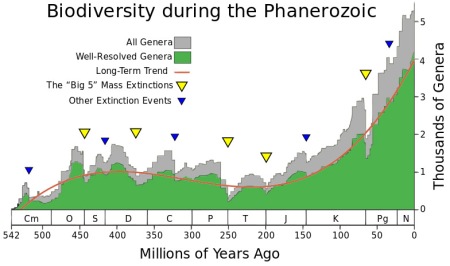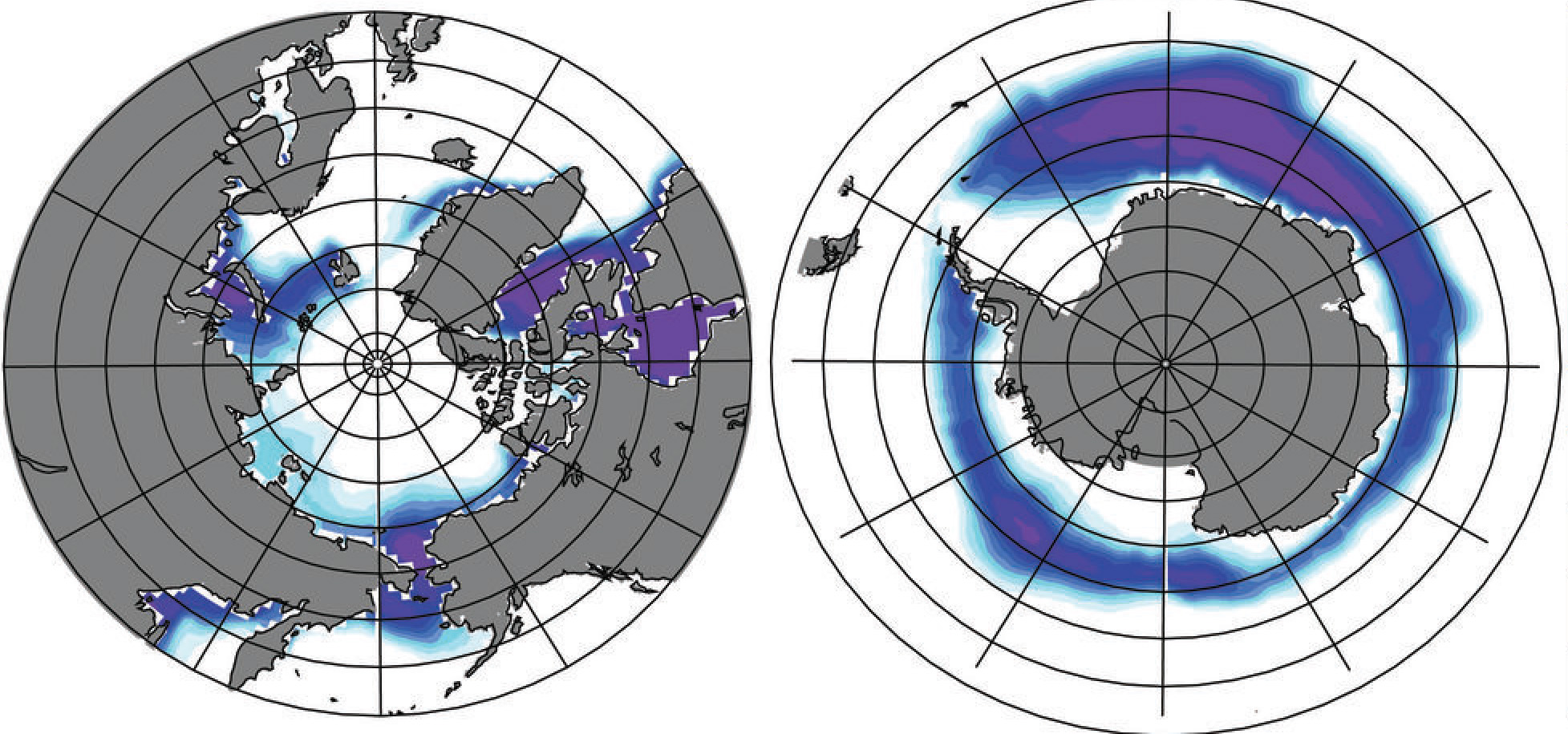A new paper addresses the drivers behind the 3rd great “mass extinction” around 250 million years ago. It finds that it was due to an ice age and not due to global warming as many have speculated.
Björn Baresel, Hugo Bucher, Borhan Bagherpour, Morgane Brosse, Kuang Guodun, Urs Schaltegger. Timing of global regression and microbial bloom linked with the Permian-Triassic boundary mass extinction: implications for driving mechanisms. Scientific Reports, 2017; 7: 43630 DOI: 10.1038/srep43630
Universite de Geneve Press Release:
The Earth has known several mass extinctions over the course of its history. One of the most important happened at the Permian-Triassic boundary 250 million years ago. Over 95% of marine species disappeared and, up until now, scientists have linked this extinction to a significant rise in Earth temperatures. But researchers from the University of Geneva (UNIGE), Switzerland, working alongside the University of Zurich, discovered that this extinction took place during a short ice age which preceded the global climate warming. It’s the first time that the various stages of a mass extinction have been accurately understood and that scientists have been able to assess the major role played by volcanic explosions in these climate processes. This research, which can be read in Scientific Reports, completely calls into question the scientific theories regarding these phenomena, founded on the increase of CO2 in the atmosphere, and paves the way for a new vision of the Earth’s climate history.
Teams of researchers led by Professor Urs Schaltegger from the Department of Earth and Environmental Sciences at the Faculty of Science of the UNIGE and by Hugo Bucher, from the University of Zürich, have been working on absolute dating for many years. They work on determining the age of minerals in volcanic ash, which establishes a precise and detailed chronology of the earth’s climate evolution. They became interested in the Permian-Triassic boundary, 250 million years ago, during which one of the greatest mass extinctions ever took place, responsible for the loss of 95% of marine species. How did this happen? for how long marine biodiversity stayed at very low levels?
Researchers worked on sediment layers in the Nanpanjiang basin in southern China. They have the particularity of being extremely well preserved, which allowed for an accurate study of the biodiversity and the climate history of the Permian and the Triassic. “We made several cross-sections of hundreds of metres of basin sediments and we determined the exact positions of ash beds contained in these marine sediments,” explained Björn Baresel, first author of the study. They then applied a precise dating technique based on natural radioactive decay of uranium, as Urs Schaltegger added: “In the sedimentary cross-sections, we found layers of volcanic ash containing the mineral zircon which incorporates uranium. It has the specificity of decaying into lead over time at a well-known speed. This is why, by measuring the concentrations of uranium and lead, it was possible for us to date a sediment layer to an accuracy of 35,000 years, which is already fairly precise for periods over 250 million years.”
Ice is responsible for mass extinctionBy dating the various sediment layers, researchers realised that the mass extinction of the Permian-Triassic boundary is represented by a gap in sedimentation, which corresponds to a period when the sea-water level decreased. The only explanation to this phenomenon is that there was ice, which stored water, and that this ice age which lasted 80,000 years was sufficient to eliminate much of marine life. Scientists from the UNIGE explain the global temperature drop by a stratospheric injection of large amounts of sulphur dioxide reducing the intensity of solar radiation reaching the surface of the earth. “We therefore have proof that the species disappeared during an ice age caused by the activity of the first volcanism in the Siberian Traps,” added Urs Schaltegger. This ice age was followed by the formation of limestone deposits through bacteria, marking the return of life on Earth at more moderate temperatures. The period of intense climate warming, related to the emplacement of large amounts of basalt of the Siberian Traps and which we previously thought was responsible for the extinction of marine species, in fact happened 500,000 years after the Permian-Triassic boundary.
This study therefore shows that climate warming is not the only explanation of global ecological disasters in the past on Earth: it is important to continue analysing ancient marine sediments to gain a deeper understanding of the earth’s climate system.
We now have more living species than ever before. The number of “garbage” species is very high and a new “mass extinction” (the sixth) is needed to clear out the rubbish. A Herculean task and hopefully humans will not be one of the “garbage” species. When it comes it is more likely to be due to a global cooling than a global warming.
There are thought to have been 5 great “mass extinctions” in the past. A “mass extinction” removes around 30 – 50% of extent species and can be seen as a self-correcting method for getting rid of the detritus remaining from failed evolution.
But I would argue instead that mass extinctions are necessary and unavoidable. They are necessitated by the ineffectiveness of the process of evolution itself. They provide the self-correction necessary to cope with the mass of “rubbish” species created by the hit-and-miss process of evolution. The external shock is only incidental and acts as the trigger for the extinction of the highly-stressed “rubbish” species. None of the historical mass extinctions ever posed any threat to the continuation of life. Instead they have served to muck out the dung from the evolutionary stables.
The fossil record shows that biodiversity in the world has been increasing dramatically for 200 million years and is likely to continue. The two mass extinctions in that period (at 201 million and 66 million years ago) slowed the trend only temporarily. Genera are the next taxonomic level up from species and are easier to detect in fossils. The Phanerozoic is the 540-million-year period in which animal life has proliferated. Chart created by and courtesy of University of Chicago paleontologists J. John Sepkoski, Jr. and David M. Raup.
The clue lies here:
Wikipedia: Although there are 10–14 million species of life currently on the Earth, more than 99 percent of all species that ever lived on the planet are estimated to be extinct.
Evolution fails in over 99% of its attempts to create species that can survive. The 1% of species that do and have survived may seem to be perfectly tailored for the prevailing conditions but that is putting the cart before the horse. Evolution has no direction and does not seek excellence. It only throws up a plethora of species where just 1% of those species happen to suit the prevailing conditions. One round peg out of a 100 different shapes may happen to fit a round hole but the round peg itself was not designed to fit – it happened to be the only one of many which did. For every species which is just good enough to survive, evolution gives another 99 which are not. As a process it is a remarkably ineffective one. Humans are not the result of “intelligent design”. They are just the 1% of all the species created by evolution which happened to fit the round hole of the prevailing environment.








